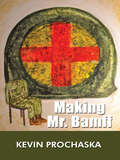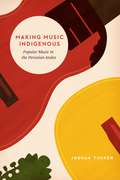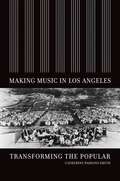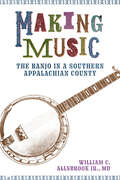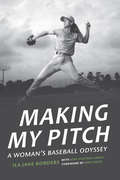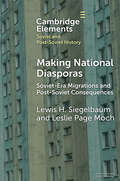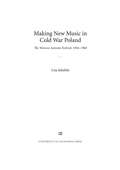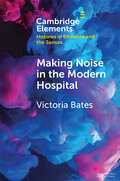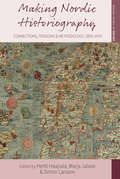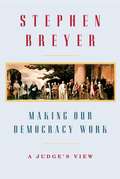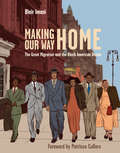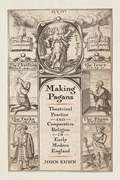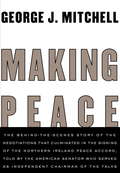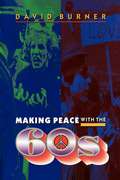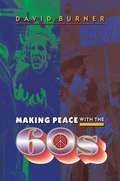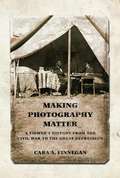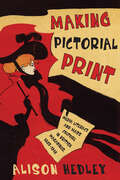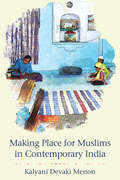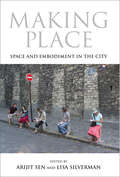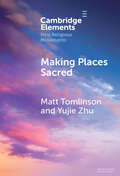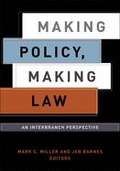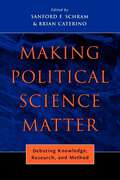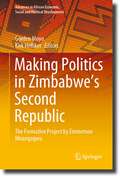- Table View
- List View
Making Mr. Bamff
by Kevin ProchaskaDuring the winter of 1944, American and German armies are locked in a desperate, bloody battle in the Hurtgen forest on the German-Belgium border. The forest, of no military significance, has become a point of pride to American commanders who stubbornly throw division after division into the costly campaign. A squad of American soldiers advances cautiously on a night patrol, hunting the enemy among the dense fir trees. They become victims of landmine explosion, and the squad leader is the lone survivor of the blast, his wounds rendering him unable to move or speak. A mysterious stranger emerges from the darkness and drags the wounded man to safety. The soldier is relieved to learn that his rescuer is an army medic, but with the coming of the new day, discovers that they are alone in an obscure rock quarry, home to a tombstone carver. Dead soldiers from the two armies are neatly arranged in stacks on the quarry floor. The soldier soon realizes that his rescuer has been severely traumatized by the carnage of war. The medic has witnessed bloodied and mangled soldiers, many of them close friends, suffer horribly. Eventually overcome with guilt as soldiers under his care continue to die, the medic is a broken man seeking escape through the morphine drugs he carries. The wounded soldier becomes caught up in the man's spiraling descent into insanity. The medic, yearning for the peaceful times he knew before the war, has deserted his unit and roams the forest at night, collecting the bodies of the dead. In his morphine-fueled madness, he is determined to bring back to life his good friend and mentor, Mr. Bamff, the kindly janitor from his high school days. Convinced that, with his friend's resurrection, the world would once again be the utopia it had been, the man is willing to do whatever it takes to make his Mr. Bamff.
Making Music Indigenous: Popular Music in the Peruvian Andes (Chicago Studies in Ethnomusicology)
by Joshua TuckerWhen thinking of indigenous music, many people may imagine acoustic instruments and pastoral settings far removed from the whirl of modern life. But, in contemporary Peru, indigenous chimaycha music has become a wildly popular genre that is even heard in the nightclubs of Lima. In Making Music Indigenous, Joshua Tucker traces the history of this music and its key performers over fifty years to show that there is no single way to “sound indigenous.” The musicians Tucker follows make indigenous culture and identity visible in contemporary society by establishing a cultural and political presence for Peru’s indigenous peoples through activism, artisanship, and performance. This musical representation of indigeneity not only helps shape contemporary culture, it also provides a lens through which to reflect on the country’s past. Tucker argues that by following the musicians that have championed chimaycha music in its many forms, we can trace shifting meanings of indigeneity—and indeed, uncover the ways it is constructed, transformed, and ultimately recreated through music.
Making Music in Los Angeles: Transforming the Popular
by Catherine Parsons SmithIn this social history of music in Los Angeles from the 1880s to 1940, Catherine Parsons Smith ventures into an often neglected period to discover that during America's Progressive Era, L.A. was a center for making music long before it became a major metropolis. She describes the thriving music scene over some sixty years, including opera, concert giving and promotion, and the struggles of individuals who pursued music as an ideal, a career, a trade, a business--or all those things at once.
Making Music: The Banjo in a Southern Appalachian County (American Made Music Series)
by William C. Allsbrook Jr.The banjo has been emblematic of the Southern Appalachian Mountains since the late twentieth century. Making Music: The Banjo in a Southern Appalachian County takes a close look at the instrument and banjo players in Haywood County, North Carolina. Author William C. Allsbrook Jr., MD, presents the oral histories of thirty-two banjo players, all but two of whom were born in Haywood County. These talented musicians recount, in their own words, their earliest memories of music, and of the banjo, as well as the appeal of the banjo. They also discuss learning to play the instrument, including what it “feels like” playing the banjo, many describing occasional “flow states.”In the book, Allsbrook explores an in-home musical folkway that developed along the colonial frontier. By the mid-1800s, frontier expansion had ceased in Haywood County due to geographic barriers, but the in-home musical tradition, including the banjo, survived in largely isolated areas. Vestiges of that tradition remain to this day, although the region has undergone significant changes over the lifetimes of the musicians interviewed. As a result, the survival of the in-home tradition is not guaranteed. Readers are invited into the private lives of the banjo players and asked to consider the future of the banjo in the face of contemporary trends. The future will be shaped by how this remarkable mountain culture continues to adapt to these challenges. Still, this thriving community of banjo players represents the vibrant legacy of the banjo in Haywood County and the persistence of tradition in the twenty-first century.
Making My Pitch: A Woman's Baseball Odyssey
by Ila Jane Borders Jean Hastings Ardell Mike VeeckMaking My Pitch tells the story of Ila Jane Borders, who despite formidable obstacles became a Little League prodigy, MVP of her otherwise all-male middle school and high school teams, the first woman awarded a baseball scholarship, and the first to pitch and win a complete men’s collegiate game. After Mike Veeck signed Borders in May 1997 to pitch for his St. Paul Saints of the independent Northern League, she accomplished what no woman had done since the Negro Leagues era: play men’s professional baseball. Borders played four professional seasons and in 1998 became the first woman in the modern era to win a professional ball game. Borders had to find ways to fit in with her teammates, reassure their wives and girlfriends, work with the media, and fend off groupies. But these weren’t the toughest challenges. She had a troubled family life, a difficult adolescence as she struggled with her sexual orientation, and an emotionally fraught college experience as a closeted gay athlete at a Christian university. Making My Pitch shows what it’s like to be the only woman on the team bus, in the clubhouse, and on the field. Raw, open, and funny at times, her story encompasses the loneliness of a groundbreaking pioneer who experienced grave personal loss. Borders ultimately relates how she achieved self-acceptance and created a life as a firefighter and paramedic and as a coach and goodwill ambassador for the game of baseball.
Making National Diasporas: Soviet-Era Migrations and Post-Soviet Consequences (Elements in Soviet and Post-Soviet History)
by Lewis H. Siegelbaum Leslie Page MochThis Element explains the historical conditions for the seemingly anomalous presence of people outside of 'their own' Soviet republic and the sometimes-fraught consequences for them and their post-Soviet host countries. The authors begin their inquiry with an analysis of the most massive displacements of the Stalin era – nationality-based deportations, concluding with examples of the life trajectories of deportees' children as they moved transnationally within the Soviet Union and in its successor states. The second section treats disparate parts of the country as magnets attracting Soviet citizens from far afield. Most were cities undergoing vast industrial expansion; others involved incentive programs to develop agriculture and rural-based industries. The final section is devoted to the history of immigration and emigration during the Soviet period as well as since 1991 when millions left one former Soviet republic for another or for lands farther afield.
Making National News
by Gene AllenFor almost a century, Canadian newspapers, radio and television stations, and now internet news sites have depended on the Canadian Press news agency for most of their Canadian (and, through its international alliances) foreign news. This book provides the first-ever scholarly history of CP, as well as the most wide-ranging historical treatment of twentieth-century Canadian journalism published to date.Using extensive archival research, including complete and unfettered access to CP's archives, Gene Allen traces how CP was established and evolved in the face of frequent conflicts among the powerful newspaper publishers - John Ross Robertson, Joseph Atkinson, and Roy Thomson, among others - who collectively owned it, and how the journalists who ran it understood and carried out their work. Other major themes include CP's shifting relationships with the Associated Press and Reuters; its responses to new media; its aggressive shaping of its own national role during the Second World War; and its efforts to meet the demands of French-language publishers.Making National News makes a substantial and original contribution to our understanding of journalism as a phenomenon that shaped Canada both culturally and politically in the twentieth century.
Making New Music in Cold War Poland: The Warsaw Autumn Festival, 1956-1968
by Lisa JakelskiMaking New Music in Cold War Poland presents a social analysis of new music dissemination at the Warsaw Autumn International Festival of Contemporary Music, one of the most important venues for East-West cultural contact during the Cold War. In this incisive study, Lisa Jakelski examines the festival's institutional organization, negotiations among its various actors, and its reception in Poland, while also considering the festival's worldwide ramifications, particularly the ways that it contributed to the cross-border movement of ideas, objects, and people (including composers, performers, official festival guests, and tourists). This book explores social interactions within institutional frameworks and how these interactions shaped the practices, values, and concepts associated with new music.
Making Noise in the Modern Hospital (Elements in Histories of Emotions and the Senses)
by Victoria BatesThis Element examines the problem of hospital noise, a problem that has repeatedly been discovered anew, with each new era bringing its own efforts to control and abate unwanted sound in healthcare settings. Why, then, has hospital noise never been resolved? This question is at the heart of Making Noise in the Modern Hospital, which brings together histories of the senses, space, technology, society, medicine and architecture to understand the changing cacophony of the late twentieth-century hospital. This Element is fundamentally interdisciplinary – despite being historical, it comes up to the present day and brings in scholarship on space, place, atmosphere and the senses that will have relevance to scholars working outside of historical research. The intersection between medical and sensory histories also puts interdisciplinary research at the Element's core.
Making Nordic Historiography: Connections, Tensions and Methodology, 1850-1970
by Marja Jalava Pertti Haapala Simon LarssonIs there a "Nordic history"? If so, what are its origins, its scope, and its defining features? In this informative volume, scholars from all five Nordic nations tackle a notoriously problematic historical concept. Whether recounting Foucault's departure from Sweden or tracing the rise of movements such as "aristocratic empiricism," each contribution takes a deliberately transnational approach that is grounded in careful research, yielding rich, nuanced perspectives on shifting and contested historical terrain.
Making North America
by James A. ThompsonMuch has been written about the trilateral relationship between Canada, the United States, and Mexico, and the free trade agreements that this relationship has spawned. In Making North America, James Thompson uses the Canada-US Free Trade Agreement of 1988 and the North American Free Trade Agreement of 1994 to demonstrate that there has been an often-unrecognized impulse behind the process of North American integration - national security.Featuring interviews with key decision-makers from all three countries, including Brian Mulroney, George H.W. Bush, and Carlos Salinas, Making North America is a rigorous analysis of the role national security has played in North American integration. Furthermore, Thompson's evidence suggests that the processes at work in North America are part of a global phenomenon where regions are progressively coalescing into larger-scale political entities.
Making Our Democracy Work: A Judge's View
by Stephen BreyerThe Supreme Court is one of the most extraordinary institutions in our system of government. Charged with the responsibility of interpreting the Constitution, the nine unelected justices of the Court have the awesome power to strike down laws enacted by our elected representatives. Why does the public accept the Court's decisions as legitimate and follow them, even when those decisions are highly unpopular? What must the Court do to maintain the public's faith? How can the Court help make our democracy work? These are the questions that Justice Stephen Breyer tackles in this groundbreaking book. Today we assume that when the Court rules, the public will obey. But Breyer declares that we cannot take the public's confidence in the Court for granted. He reminds us that at various moments in our history, the Court's decisions were disobeyed or ignored. And through investigations of past cases, concerning the Cherokee Indians, slavery, and Brown v. Board of Education, he brilliantly captures the steps--and the missteps--the Court took on the road to establishing its legitimacy as the guardian of the Constitution. Justice Breyer discusses what the Court must do going forward to maintain that public confidence and argues for interpreting the Constitution in a way that works in practice. He forcefully rejects competing approaches that look exclusively to the Constitution's text or to the eighteenth-century views of the framers. Instead, he advocates a pragmatic approach that applies unchanging constitutional values to ever-changing circumstances--an approach that will best demonstrate to the public that the Constitution continues to serve us well. The Court, he believes, must also respect the roles that other actors--such as the president, Congress, administrative agencies, and the states--play in our democracy, and he emphasizes the Court's obligation to build cooperative relationships with them. Finally, Justice Breyer examines the Court's recent decisions concerning the detainees held at Guantánamo Bay, contrasting these decisions with rulings concerning the internment of Japanese-Americans during World War II. He uses these cases to show how the Court can promote workable government by respecting the roles of other constitutional actors without compromising constitutional principles. Making Our Democracy Work is a tour de force of history and philosophy, offering an original approach to interpreting the Constitution that judges, lawyers, and scholars will look to for many years to come. And it further establishes Justice Breyer as one of the Court's greatest intellectuals and a leading legal voice of our time.
Making Our Way Home: The Great Migration and the Black American Dream
by Blair ImaniA powerful illustrated history of the Great Migration and its sweeping impact on Black and American culture, from Reconstruction to the rise of hip hop.Over the course of six decades, an unprecedented wave of Black Americans left the South and spread across the nation in search of a better life--a migration that sparked stunning demographic and cultural changes in twentieth-century America. Through gripping and accessible historical narrative paired with illustrations, author and activist Blair Imani examines the largely overlooked impact of The Great Migration and how it affected--and continues to affect--Black identity and America as a whole. Making Our Way Home explores issues like voting rights, domestic terrorism, discrimination, and segregation alongside the flourishing of arts and culture, activism, and civil rights. Imani shows how these influences shaped America's workforce and wealth distribution by featuring the stories of notable people and events, relevant data, and family histories. The experiences of prominent figures such as James Baldwin, Fannie Lou Hamer, El Hajj Malik El Shabazz (Malcolm X), Ella Baker, and others are woven into the larger historical and cultural narratives of the Great Migration to create a truly singular record of this powerful journey.
Making Pagans: Theatrical Practice and Comparative Religion in Early Modern England (Published in cooperation with the Folger Shakespeare Library)
by John KuhnHow early modern theatrical practice helped construct the category of “pagan” as a tool of European self-definition and colonial ambitionIn Making Pagans, John Kuhn argues that drama played a powerful role in the articulation of religious difference in the seventeenth century. Tracing connections between the history of stagecraft and ethnological disciplines such as ethnography, antiquarianism, and early comparative religious writing, Kuhn shows how early modern repertory systems that leaned heavily on thrift and reuse produced an enduring theatrical vocabulary for understanding religious difference through the representation of paganism—a key term in the new taxonomy of world religions emerging at this time, and a frequent subject and motif in English drama of the era.Combining properties such as triumphal chariots, trick altars, and moving statues with music, special effects, and other elements, the spectacular set-pieces that were mostly developed for plays set in antiquity, depicting England’s pre-Christian past, were frequently repurposed in new plays, in representations of Native Americans and Africans in colonial contact zones. Kuhn argues that the recycling of these set-pieces encouraged audiences to process new cultural sites through the lens of old performance tropes, and helped produce fictitious, quasi-ethnographic knowledge for spectators, generating the idea of a homogeneous, trans-historical, trans-geographical “paganism.” Examining the common scenes of pagan ritual that filled England's seventeenth-century stages—magical conjurations, oracular prophecies, barbaric triumphal parades, and group suicides—Kuhn traces these tropes across dozens of plays, from a range of authors including Ben Jonson, Christopher Marlowe, John Dryden, and Philip Massinger.Drawing together theater history, Atlantic studies, and the history of comparative religion, Making Pagans reconceptualizes the material and iterative practices of the theater as central to the construction of radical religious difference in early modernity and of the category of paganism as a tool of European self-definition and colonial ambition.
Making Peace
by George MitchellFifteen minutes before five o'clock on Good Friday, 1998, Senator George Mitchell was informed that his long and difficult quest for an Irish peace accord had succeeded--the Protestants and Catholics of Northern Ireland, and the governments of the Republic of Ireland and the United Kingdom, would sign the agreement. Now Mitchell, who served as independent chairman of the peace talks for the length of the process, tells us the inside story of the grueling road to this momentous accord.For more than two years, Mitchell, who was Senate majority leader under Presidents Bush and Clinton, labored to bring together parties whose mutual hostility--after decades of violence and mistrust--seemed insurmountable: Sinn Fein, represented by Gerry Adams; the Catholic moderates, led by John Hume; the majority Protestant party, headed by David Trimble; Ian Paisley's hard-line unionists; and, not least, the governments of the Republic of Ireland and the United Kingdom, headed by Bertie Ahern and Tony Blair.The world watched as the tense and dramatic process unfolded, sometimes teetering on the brink of failure. Here, for the first time, we are given a behind-the-scenes view of the principal players--the personalities who shaped the process--and of the contentious, at times vitriolic, proceedings. We learn how, as the deadline approached, extremist violence and factional intransigence almost drove the talks to collapse. And we witness the intensity of the final negotiating session, the interventions of Ahern and Blair, the late-night phone calls from President Clinton, a last-ditch attempt at disruption by Paisley, and ultimately an agreement that, despite subsequent inflammatory acts aimed at destroying it, has set Northern Ireland's future on track toward a more lasting peace.
Making Peace With The 60s
by David BurnerDavid Burner's panoramic history of the 1960s conveys the ferocity of debate and the testing of visionary hopes that still require us to make sense of the decade. He begins with the civil rights and black power movements and then turns to nuanced descriptions of Kennedy and the Cold War, the counterculture and its antecedents in the Beat Generation, the student rebellion, the poverty wars, and the liberals' war in Vietnam. As he considers each topic, Burner advances a provocative argument about how liberalism self-destructed in the 1960s. In his view, the civil rights movement took a wrong turn as it gradually came to emphasize the identity politics of race and ethnicity at the expense of the vastly more important politics of class and distribution of wealth. The expansion of the Vietnam War did force radicals to confront the most terrible mistake of American liberalism, but that they also turned against the social goals of the New Deal was destructive to all concerned. <p><p> Liberals seemed to rule in politics and in the media, Burner points out, yet they failed to make adequate use of their power to advance the purposes that both liberalism and the left endorsed. And forces for social amelioration splintered into pairs of enemies, such as integrationists and black separatists, the social left and mainline liberalism, and advocates of peace and supporters of a totalitarian Hanoi. <p> Making Peace with the 60s will fascinate baby boomers and their elders, who either joined, denounced, or tried to ignore the counterculture. It will also inform a broad audience of younger people about the famous political and literary figures of the time, the salient moments, and, above all, the powerful ideas that spawned events from the civil rights era to the Vietnam War. Finally, it will help to explain why Americans failed to make full use of the energies unleashed by one of the most remarkable decades of our history.
Making Peace with the 60s
by David BurnerDavid Burner's panoramic history of the 1960s conveys the ferocity of debate and the testing of visionary hopes that still require us to make sense of the decade. He begins with the civil rights and black power movements and then turns to nuanced descriptions of Kennedy and the Cold War, the counterculture and its antecedents in the Beat Generation, the student rebellion, the poverty wars, and the liberals' war in Vietnam. As he considers each topic, Burner advances a provocative argument about how liberalism self-destructed in the 1960s. In his view, the civil rights movement took a wrong turn as it gradually came to emphasize the identity politics of race and ethnicity at the expense of the vastly more important politics of class and distribution of wealth. The expansion of the Vietnam War did force radicals to confront the most terrible mistake of American liberalism, but that they also turned against the social goals of the New Deal was destructive to all concerned.Liberals seemed to rule in politics and in the media, Burner points out, yet they failed to make adequate use of their power to advance the purposes that both liberalism and the left endorsed. And forces for social amelioration splintered into pairs of enemies, such as integrationists and black separatists, the social left and mainline liberalism, and advocates of peace and supporters of a totalitarian Hanoi.Making Peace with the 60s will fascinate baby boomers and their elders, who either joined, denounced, or tried to ignore the counterculture. It will also inform a broad audience of younger people about the famous political and literary figures of the time, the salient moments, and, above all, the powerful ideas that spawned events from the civil rights era to the Vietnam War. Finally, it will help to explain why Americans failed to make full use of the energies unleashed by one of the most remarkable decades of our history.
Making Photography Matter: A Viewer's History from the Civil War to the Great Depression
by Cara A. FinneganPhotography became a dominant medium in cultural life starting in the late nineteenth century. As it happened, viewers increasingly used their reactions to photographs to comment on and debate public issues as vital as war, national identity, and citizenship. Cara A. Finnegan analyzes a wealth of newspaper and magazine articles, letters to the editor, trial testimony, books, and speeches produced by viewers in response to specific photos they encountered in public. From the portrait of a young Lincoln to images of child laborers and Depression-era hardship, Finnegan treats the photograph as a locus for viewer engagement and constructs a history of photography's viewers that shows how Americans used words about images to participate in the politics of their day. As she shows, encounters with photography helped viewers negotiate the emergent anxieties and crises of U.S. public life through not only persuasion but action, as well.
Making Pictorial Print: Media Literacy and Mass Culture in British Magazines, 1885–1918 (Studies in Book and Print Culture)
by Alison HedleyAt the end of the nineteenth century, print media dominated British popular culture, produced in greater variety and on a larger scale than ever before. Within decades, new visual and auditory media had ushered in a mechanized milieu, displacing print from its position at the heart of cultural life. During this period of intense change, illustrated magazines maintained a central position in the media landscape by transforming their letterpress orientation into a visual and multimodal one. Ultimately, this transformation was important for the new media cultures of the twentieth and twenty-first centuries. Making Pictorial Print recovers this chapter in the history of new media, applying concepts from media theory and the digital humanities to analyse four popular late-Victorian magazines – the Illustrated London News, the Graphic, Pearson’s Magazine, and the Strand – and the scrapbook media that appropriated them. Using the concept of media literacy, these case studies demonstrate the ways in which periodical design aesthetics affected the terms of engagement presented to readers, creating opportunities for them to participate in and even contribute to popular culture. Shaped by publishers, advertisers, and readers themselves, the pages of these periodicals document the emergence of modern mass culture as we know it and offer insight into the new media of our digital present.
Making Place for Muslims in Contemporary India
by Kalyani Devaki MenonMaking Place for Muslims in Contemporary India looks at how religion provides an arena to make place and challenge the majoritarian, exclusionary, and introverted tendencies of contemporary India.Places do not simply exist. They are made and remade by the acts of individuals and communities at particular historical moments. In India today, the place for Muslims is shrinking as the revanchist Hindu Right increasingly realizes its vision of a Hindu nation. Religion enables Muslims to re-envision India as a different kind of place, one to which they unquestionably belong. Analyzing the religious narratives, practices, and constructions of religious subjectivity of diverse groups of Muslims in Old Delhi, Kalyani Devaki Menon reveals the ways in which Muslims variously contest the insular and singular understandings of nation that dominate the sociopolitical landscape of the country and make place for themselves. Menon shows how religion is concerned not just with the divine and transcendental but also with the anxieties and aspirations of people living amid violence, exclusion, and differential citizenship. Ultimately, Making Place for Muslims in Contemporary India allows us to understand religious acts, narratives, and constructions of self and belonging as material forces, as forms of the political that can make room for individuals, communities, and alternative imaginings in a world besieged by increasingly xenophobic understandings of nation and place.
Making Place: Space And Embodiment In The City
by Arijit Sen Lisa SilvermanSpace and place have become central to analysis of culture and history in the humanities and social sciences. Making Place examines how people engage the material and social worlds of the urban environment via the rhythms of everyday life and how bodily responses are implicated in the making and experiencing of place. The contributors introduce the concept of spatial ethnography, a new methodological approach that incorporates both material and abstract perspectives in the study of people and place, and encourages consideration of the various levels--from the personal to the planetary--at which spatial change occurs. The book's case studies come from Costa Rica, Colombia, India, Austria, Italy, the United Kingdom, and the United States.
Making Places Sacred: New Articulations of Place and Power (Elements in New Religious Movements)
by Matt Tomlinson Yujie ZhuAlthough claims to sacredness are often linked to the power of a distant past, the work of making places sacred is creative, novel, renewable, and reversible. This Element highlights how sacred space is newly made. It is often associated with blood, death, and geographic anomalies, yet no single feature determines sacred associations. People make space sacred by connecting with 'extrahuman' figures – the ancestors, spirits, and gods that people attempt to interact with in every society. These connections can be concentrated in people's bodies, yet bodies are particularly vulnerable to loss. The Element also examines the multidimensional and multisensory dimensions of sacred space, which can be made almost anywhere, including online, but can also be unmade. Unmaking sacred space can entail new sacralization. New and minority religions in particular provide excellent sites for studying sacredness as a value, raising the reliably productive question: sacred for whom?
Making Policy, Making Law: An Interbranch Perspective (American Governance And Public Policy)
by Mark Miller Jeb Barnes Robert KatzmannThe functioning of the U.S. government is a bit messier than Americans would like to think. The general understanding of policymaking has Congress making the laws, executive agencies implementing them, and the courts applying the laws as written--as long as those laws are constitutional. Making Policy, Making Law fundamentally challenges this conventional wisdom, arguing that no dominant institution--or even a roughly consistent pattern of relationships--exists among the various players in the federal policymaking process. Instead, at different times and under various conditions, all branches play roles not only in making public policy, but in enforcing and legitimizing it as well. This is the first text that looks in depth at this complex interplay of all three branches. The common thread among these diverse patterns is an ongoing dialogue among roughly coequal actors in various branches and levels of government. Those interactions are driven by processes of conflict and persuasion distinctive to specific policy arenas as well as by the ideas, institutional realities, and interests of specific policy communities. Although complex, this fresh examination does not render the policymaking process incomprehensible; rather, it encourages scholars to look beyond the narrow study of individual institutions and reach across disciplinary boundaries to discover recurring patterns of interbranch dialogue that define (and refine) contemporary American policy. Making Policy, Making Law provides a combination of contemporary policy analysis, an interbranch perspective, and diverse methodological approaches that speak to a surprisingly overlooked gap in the literature dealing with the role of the courts in the American policymaking process. It will undoubtedly have significant impact on scholarship about national lawmaking, national politics, and constitutional law. For scholars and students in government and law--as well as for concerned citizenry--this book unravels the complicated interplay of governmental agencies and provides a heretofore in-depth look at how the U.S. government functions in reality.
Making Political Science Matter: Debating Knowledge, Research, and Method
by Sanford F. Schram Brian CaterinoMaking Political Science Matter brings together a number of prominent scholars to discuss the state of the field of Political Science. In particular, these scholars are interested in ways to reinvigorate the discipline by connecting it to present day political struggles. Uniformly well-written and steeped in a strong sense of history, the contributors consider such important topics as: the usefulness of rational choice theory; the ethical limits of pluralism; the use (and misuse) of empirical research in political science; the present-day divorce between political theory and empirical science; the connection between political science scholarship and political struggles, and the future of the discipline. This volume builds on the debate in the discipline over the significance of the work of Bent Flyvbjerg, whose book Making Social Science Matter has been characterized as a manifesto for the Perestroika Movement that has roiled the field in recent years.Contributors include: Brian Caterino, Stewart Clegg, Bent Flyvbjerg, Mary Hawkesworth, Patrick Thaddeus Jackson, Gregory J. Kasza, David Kettler, David D. Laitin, Timothy W. Luke, Theodore R. Schatzki, Sanford F. Schram, Peregrine Schwartz-Shea, Corey S. Shdaimah, Roland W. Stahl, and Leslie Paul Thiele.
Making Politics in Zimbabwe’s Second Republic: The Formative Project by Emmerson Mnangagwa (Advances in African Economic, Social and Political Development)
by Kirk Helliker Gorden MoyoThe book provides a fresh and innovative interpretation of the new government of Zimbabwe led by Emmerson Mnangagwa, which emerged in late 2017 after the downfall of Robert Mugabe. It demonstrates the contradictory character of the Mnangagwa government, involving both continuities and discontinuities in relation to Mugabe’s regime . The temptation amongst Zimbabwean scholars has been to focus on the continuities and to dismiss the significance of any discontinuities, notably reform measures. This book adopts an alternative approach by identifying and focusing specifically on the existence of a formative project of the Mnangagwa’s Second Republic, further analysing its political significance, as well as risks and limitations. While doing so, the book covers topics such as reform measures, reconciliation, transitional justice, corruption, the media, agriculture, devolution, and the debt crisis as well as health and education. Discussing the limitations of these different reform measures, the book highlights that any scholarly failure to identify the risks of the project leads to an incomplete understanding of what constitutes the Mnangagwa’s Second Republic. The book appeals to students, scholars and researchers of Zimbabwean and African studies, political science and international relations, as well as policymakers interested in a better understanding of political reform processes.
